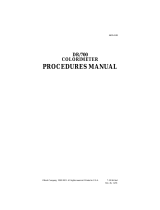
CE-Konformitätserklärung / Declaration of CE-Conformity
Déclaration de conformité CE / Dichiarazione di conformità CE /
CE-Declaración de conformidad
———————————————————————————————————————
Hersteller / manufacturer / fabricant / produttore / fabricante:
Tintometer GmbH / Schleefstraße 8-12 / 44287 Dortmund / Deutschland
———————————————————————————————————————
Produktname / Product name / Nom du fabricant / Nome del prodotto / Nombre del
productor: MD 100
———————————————————————————————————————
EG-Konformitätserklärung gemäß RICHTLINIE 2004/108/EG DES
EUROPÄISCHEN PARLAMENTS UND DES RATES vom 15. Dezember 2004 und
RICHTLINIE 2011/65/EU DES EUROPÄISCHEN PARLAMENTS UND DES RATES
vom 8. Juni 2011. Der Hersteller erklärt, dass dieses Produkt die Anforderungen
der folgenden Produktfamiliennorm erfüllt:
Declaration of EC-Conformity according to DIRECTIVE 2004/108/EC OF THE
EUROPEAN PARLIAMENT AND OF THE COUNCIL of 2004, December the 15
th
and DIRECTIVE 2011/65/EU OF THE EUROPEAN PARLIAMENT AND OF THE
COUNCIL of 2011, June the 8
th
. The manufacturer declares that this product
meets the requirements of the following product family standard:
Déclaration de conformité CE conformément à la DIRECTIVE 2004/108/CE DU
PARLEMENT EUROPÉEN ET DU CONSEIL du 15 décembre 2004 et DIRECTIVE
2011/65/UE DU PARLEMENT EUROPÉEN ET DU CONSEIL du 8 juin 2011. La
fabricant déclare que le produit est conforme aux exigences de la norme de
famille de produits suivante :
Dichiarazione di conformità CE in conformità alla DIRETTIVA 2004/108/CE DEL
PARLAMENTO EUROPEO E DEL CONSIGLIO del 15 dicembre 2004 e DIRETTIVA
2011/65/UE DEL PARLAMENTO EUROPEO E DEL CONSIGLIO del 8 Giugno 2011.
Il produttore dichiara che il seguente prodotto soddisfa i requisiti della seguente
norma per famiglia di prodotti:
CE - Declaración de conformidad conforme a la NORMA 2004/108/CE DEL
PARLAMENTO Y DEL CONSEJO EUROPEO del 15 de diciembre de 2004 y
NORMA 2011/65/UE DEL PARLAMENTO Y DEL CONSEJO EUROPEO del 8 de
junio de 2011. El fabricante declara, que este producto cumple con las
exigencias de la siguiente norma correspondiente a la familia de productos:
———————————————————————————————————————
DIN EN 61326-1:2006
———————————————————————————————————————
Gemäß den grundlegenden Prüfanforderungen für die Störfestigkeit (Tabelle 1) /
Störaussendungen gemäß den Anforderungen für Geräte der Klasse B
Basic immunity test requirements (Table1) / Emission according to the
requirements for class B equipment
Conformément aux exigences fondamentales relatives aux essais d'immunité
(tableau 1) / Émissions parasites conformément aux exigences applicables aux
appareils de la classe B
Conforme ai requisiti relativi al test di resistenza alle interferenze (Tabella 1) /
Emissione in conformità ai requisiti per i dispositivi della classe B
De acuerdo a los requisitos básicos de verificación para la resistencia a
interferencias (tabla 1) / Emisión de interferencias conforme a las exigencias para
aparatos de clase B
Dortmund, 07.10.2014
Cay-Peter Voss, Managing Director
DE
GB
FR
IT
ES
DE
GB
FR
IT
ES
























